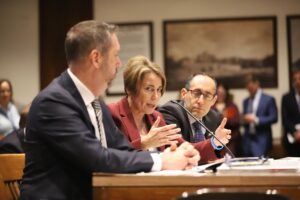
Gov. Maura Healey (center) speaks at a State House hearing on Oct. 30, 2025. She's flanked by Administration & Finance Secretary Matthew Gorzkowicz (left) and Economic Development Secretary Eric Paley (right). Photo by Ella Adams | State House News Service
Higher education, biopharma and business leaders argued Thursday that while $400 million is likely not enough to fill gaps in the higher ed and medical research sectors left by federal cuts, lawmakers need to sign onto the governor’s plan to ensure Massachusetts doesn’t fall behind in the sectors it touts the most.
“Four hundred million dollars is short money to charge our economy. There are so many needs out there, and we are spending so much time thinking about the various pots, the various places that we’re going to go to deal with the Medicaid cuts, and to deal with the infrastructure cuts, and to deal with SNAP,” Gov. Maura Healey told lawmakers Thursday after announcing that morning that she will advance $4 million to food banks in the midst of potential food aid cuts starting Nov. 1.
“This isn’t meant to be a one time Band-Aid as much as it’s meant to be a stake in the ground,” Healey said. “This will help us hold on to people, keep them from going. Because once people go, they’re not coming back. And when people go, entrepreneurs, founders, companies, go, along with hope for families looking for those life-saving cures.”
Healey filed her Discovery, Research and Innovation for a Vibrant Economy (DRIVE) bill (H.4375) on July 31, petitioning the Legislature for state investment in medical research and higher education in order to remain nationally and globally competitive.
Healey’s bill would funnel $200 million from the interest generated by the state’s rainy-day Stabilization Fund to a one-time multi-year research funding pool to support research projects at hospitals, universities and independent research institutions. Another $200 million would be placed into a higher education bridge funding reserve, funded by the Fair Share income surtax paid by wealthier households and meant to provide public higher education campuses with support for research costs.
Could Become Revolving Fund
The Review Opportunity Board, a body that would be created by the bill, would be able to create a way for the state to get back some of its return on these investments, Administration and Finance Secretary Matthew Gorzkowicz said when asked about whether the state could reinvest in the sector in a revolving manner.
Cuts to federal funding won’t just touch the institutions of higher education and medical research it directly supports, but also businesses that operate in the same ecosystem, Associated Industries of Massachusetts CEO Brooke Thomson said.
Thomson said the impact of the loss of federal funding “stands to have the exact same type of impact on small and microbusinesses that we saw with COVID,” from small biotech startups to advanced manufacturing suppliers.
Grants for invasive species climate research at UMass Amherst, fisheries research at UMass Dartmouth, human-AI decision making research at UMass Lowell and Braille instruction work at UMass Boston are also in distress, university leadership told lawmakers Thursday.
UMass Chan Medical School specifically has 55 grant submissions that have gone through the study section and council process, which would usually mean that the money would be out the door by now, Chancellor Michael Collins said.
“Thirty-four million dollars worth of grants are being held up. Over the life of those grants, it would be $171 million,” he continued. “Today, we have 284 grant applications that are in the NIH inbox. Government is closed. Nobody’s reading them. $140 million in first year costs. $635 million over the entire grant period.”
UMass Chan has had to lay off hundreds of employees, Collins said, and had to rescind some graduate school admissions because the university wasn’t sure it would have enough grant funding in the future.
Biotech Sector in Trouble
Responding to Republican concerns about job loss in the bio and tech sectors, empty lab spaces and the use of public funds that could create benefits for for-profit companies, MassBIO CEO and President Kendalle Burlin O’Connell emphasized that the biopharma industry contributes $42 billion to GDP annually, and said that if the state doesn’t continue to invest in innovation, it “will cede innovation to China absolutely within two years.”
“This is part of continuing to fuel our innovation pipeline. Is $400 million enough? Probably not. But it’s something to help fill the gap with some of these grants that are on the cusp of spinning out into companies and creating those jobs,” O’Connell said.
The latest MassBio industry survey found headcount in the state’s life science R&D shrank by 1.7 percent last year, or over 1,100 workers. The Greater Boston region alone has 19 million square feet of empty biotech real estate, largely built on speculation of an explosion of companies that never arrived thanks to a rapid rise in interest rates in 2022 and 2023.






